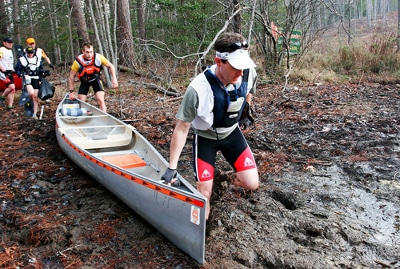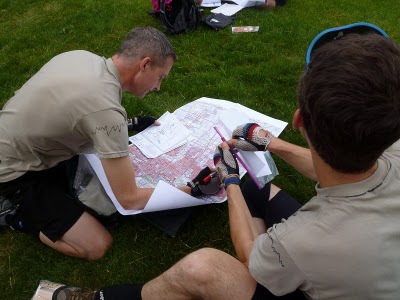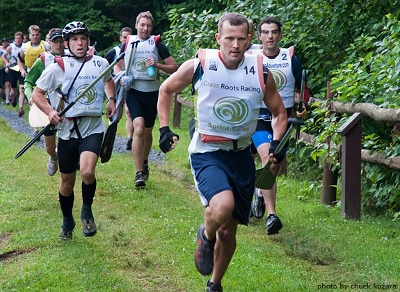
“The very greatest things – great thoughts, discoveries, inventions – have usually been nurtured in hardship, often pondered over in sorrow, and at length established with difficulty.” -Samuel Smiles, Scottish Author (1812-1904)
No outside assistance except in designated areas, no motorized travel, no “civilized” pathways, and no GPS equipment. You are responsible for hauling all of the mandatory equipment, and you provide the endurance, the skill, and the grit as you navigate your way through a wilderness race that can last as long as ten days.
Though they vary from race to race, those are the cardinal rules of adventure racing-a sport that, not surprisingly, attracts the likes of triathletes, ultra-marathon runners, mountaineers, and adventurers of all varieties looking to spice up their normal athletic routine.

What is Adventure Racing?
“The sport of adventure racing caters to, and reinforces, a disposition toward taking the hard way. It’s impossible to complete an expedition-level adventure race without pushing outward your sense of personal limits and truing your sense of what is actually needful.” – Matt Fitzgerald, Triathlete Magazine.
Adventure Racing is the puzzling lovechild of triathlons, wilderness exploration, and adventure travel. Depending on the race, a team will consist of two to five individuals in which the members must stick together throughout the course until the finish line. Adventure racing combines no fewer than two of the following endurance disciplines:
- Mountain Biking
- Trekking
- Cross-country Running
- Paddling
- Swimming
- Caving
- Climbing
- Orienteering and/or Navigation
And this list is not necessarily exhaustive. In any given event, those are the disciplines that can be expected, but part of the appeal surrounding the sport is the portion of the course where the race directors throw surprises at you. Anything from a “beast of burden” section (camels, horses, burros) to zip lines and paragliding are fair game-especially on the longer races where your endurance and sanity begin to unravel like loose twine the further into the race you get.
There are no dark periods, meaning that your team decides if and when to rest, throwing sleep deprivation into the mix as yet another obstacle to overcome.

Orienteering and Navigation
In an adventure race you are not given course markers to guide you, and travel along roads and any “civilized surfaces” is prohibited. This is where your navigation and orienteering skills come into play, making the sport not only one of physical prowess, but also a cerebral endeavor for analytically observant competitors.
Your tools include a compass, a map, and a clue sheet. Your goal is to find a series of checkpoints (tiny nylon boxes) in a specific order as you cover ground, making your way to the next transition area where you will switch to a different endurance discipline.
Expect to get lost.
Despite the fact that orienteering maps are extremely well-detailed, the checkpoints are hidden among acres of wild land, somewhere resting patiently in a course covered in woodlands, swamps, gullies, peaks and whatever other natural impediments may lie in your way. Think of it like a well-defined treasure hunt in which the treasure is a serious case of the glory and thrill of competition. Just remember to orient your compass to the map before you head out to find those nylon boxes, otherwise you may find yourself wandering in circles for hours.

Course Lengths: Something for Everyone
If all of this sounds a bit intimidating, fear not. Course lengths vary dramatically from sprint races (two to six hours) to expedition-level races (up to 10 days) in which the former are suitable for beginners and experts alike. The following is a rundown of common adventure race lengths:
Sprint: Two to six hours, they often involve surprise games of cunning or agility and feature minimal navigation.
12-Hour: Similar in make-up to the sprint races, but longer. They also feature minimal navigational skills.
Day-long: Between 18 and 30 hours. Your team should be adept at UTM-based navigation, proficient in rope skills (traversing/rappelling), and some races may require a support crew to transport your gear and supplies to the transition areas.
Multi-Day: Sleep-deprivation becomes an issue with these races that last from 36-48 hours. You will need advanced navigation skills for route choice, some ridiculous endurance, and a trusting relationship with your teammates.
Expedition: The granddaddies of adventure racing, expedition-length races are between three and ten days long. All of the previously mentioned skills are required but expeditions may also include mountaineering, beasts of burden, rope work, and technical paddling.

Why Adventure Racing?
Develop Teamwork: Adventure racing is a team sport, and its unique qualities require a skill set that parallels the recipe for success in life itself. The best teams in adventure racing are made up of individuals who have patience, strong communication, and leadership skills. You have to trust your teammates, and they must trust you–which brings us to our next point.
Learn Skills: No, you don’t have to be an expert at every endurance sport that may make up an adventure race, but you do need to be competent. Many teams assign specific jobs to each of their teammates who excel in any particular discipline. But to be safe, competitive, and have fun, teams spend significant time training together and developing a well-rounded set of skills. It is the perfect opportunity to finally learn how to actually use that compass you’ve had sitting around for years, or to improve your paddling technique for efficiency and speed.
Have a Goal to Work Towards: Pedaling mile after mile on the stationary bike at the gym with the vague goal of getting in shape isn’t very motivating or fulfilling. Pedaling a mountain bike through the woods with the goal of finishing an adventure race is. Working towards a goal gives you an unmatchable sense of purpose and satisfaction.
Adventure Close to Home: In the responses to many of our travel and adventure articles, we have found that some readers have reservations and restrictions when it comes to seeking adventure. Many of us have families and career responsibilities and lack the free time and flexible schedule required for international wandering. Luckily, the sport of adventure racing need not require expensive flights or months away from home. Adventure races exist in every state in the U.S. and even urban hybrids have developed in many areas. A quick google search of your home state and the words “adventure racing” will likely turn up something relatively close to your residence.
It’s Hard: There’s no way around that. But it can serve as an expression against the common cultural prejudice that claims: “easier is better.” If we agree with Samuel Smiles’ remark above regarding hardship, then the participation in a sport that is both mentally and physically grueling can be seen as a step taken towards the expansion of one’s limits. Hardship is a thing to embrace; it is a constant reminder of your attempt to better yourself and move forward. As Casanova famously wrote, “The best feeling in life is when one is climbing the stairs.”
While we often admire the men of the past, it is not as though they were made out of a different substance than we are. Rather, they were refined through great hardships and challenges. These hardships were an unavoidable part of life for our forebearers. These days, modern conveniences and technology have made our lives a lot easier; great challenges are no longer inevitable. So we must go and seek them out for ourselves. Adventure racing is a great way to do that.








